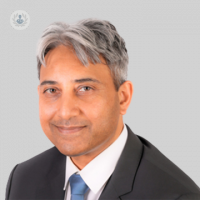Thyroplasty
Mr Taran Tatla - Otolaryngology / ENT
Created on: 12-11-2013
Updated on: 05-18-2023
Edited by: Conor Lynch
What is thyroplasty?
Thyroplasty is a surgical procedure that is performed for vocal cord paralysis. It is used to improve a patient’s voice and ability to cough. The procedure alters the thyroid cartilage of the larynx (the voice box) which houses the vocal cords, in order to change the length or position of the cords.

What causes vocal cord paralysis?
Vocal cords are found at the entrance of the trachea. Normally, the vocal cords are in an open position when at rest to allow breathing. When speaking, the vocal cords close off and vibrate. When the vocal cords are paralysed, there is a weakness in at least one of the cords that causes hoarseness and even slight choking.
How is vocal cord paralysis treated?
Treatment depends on the cause. Speech therapy is the main treatment, but if this does not help, then vocal fold injections, such as fat or collagen, can add some bulk to the vocal cord. If the vocal cord is completely paralysed, then the surgical procedure thyroplasty is performed.
How is thyroplasty performed?
The short procedure is performed under local anaesthesia and using intravenous sedation so that the surgeon can check the patient’s voice throughout the process. A small hole is made in the neck area of the voice box and the thyroid cartilage is removed to provide access to the vocal cords.
An implant is positioned near the vocal cord, which pushes the vocal cord closer to the middle section. Once in place, a fibre optic scope is inserted, which allows the surgeon to view the larynx and check that the implant is in the correct position. The patient may then be asked to speak during the laryngoscopy to enable the surgeon to check the movement of the vocal cords.
What are the risk factors of thyroplasty?
The procedure is generally safe but, as with all operations, complications can still arise. The main potential complications include:
- Poor voice quality (hoarseness) – worsening of the voice is rare
- Difficulty breathing – swelling after surgery
- Implant migration – there have been reports of migration into the airway or neck
- Bleeding – this is rare and typically stops on its own
- Infection – this is treated with antibiotics or surgery in rare cases
- Pain in the neck – which is common after surgery
